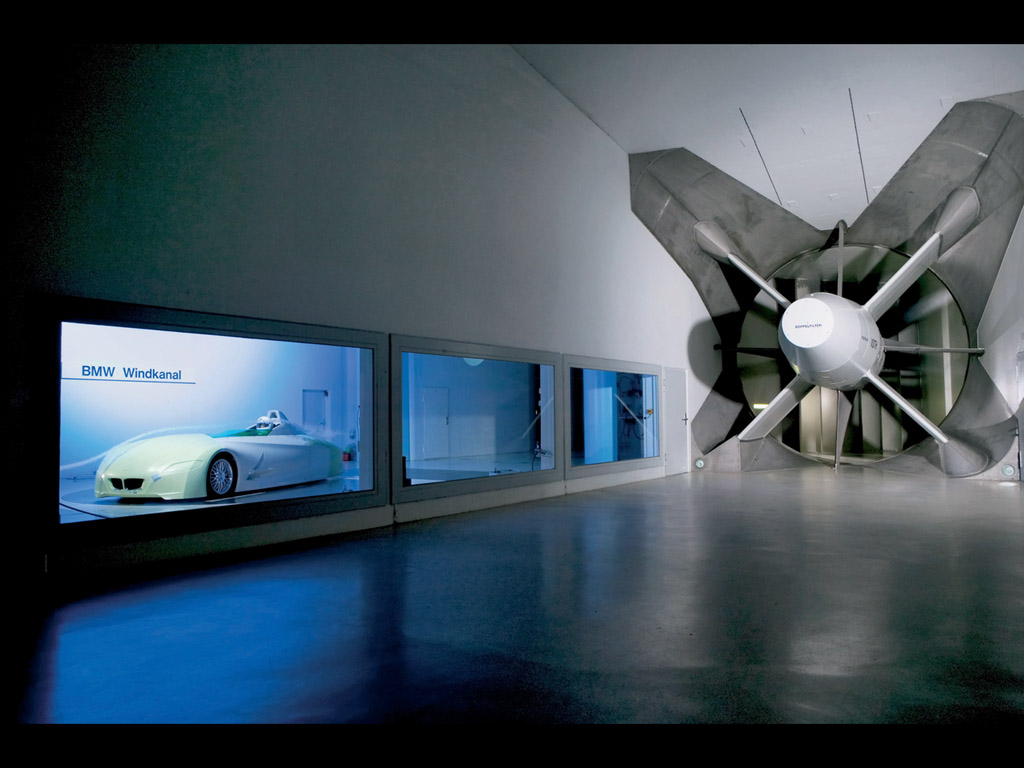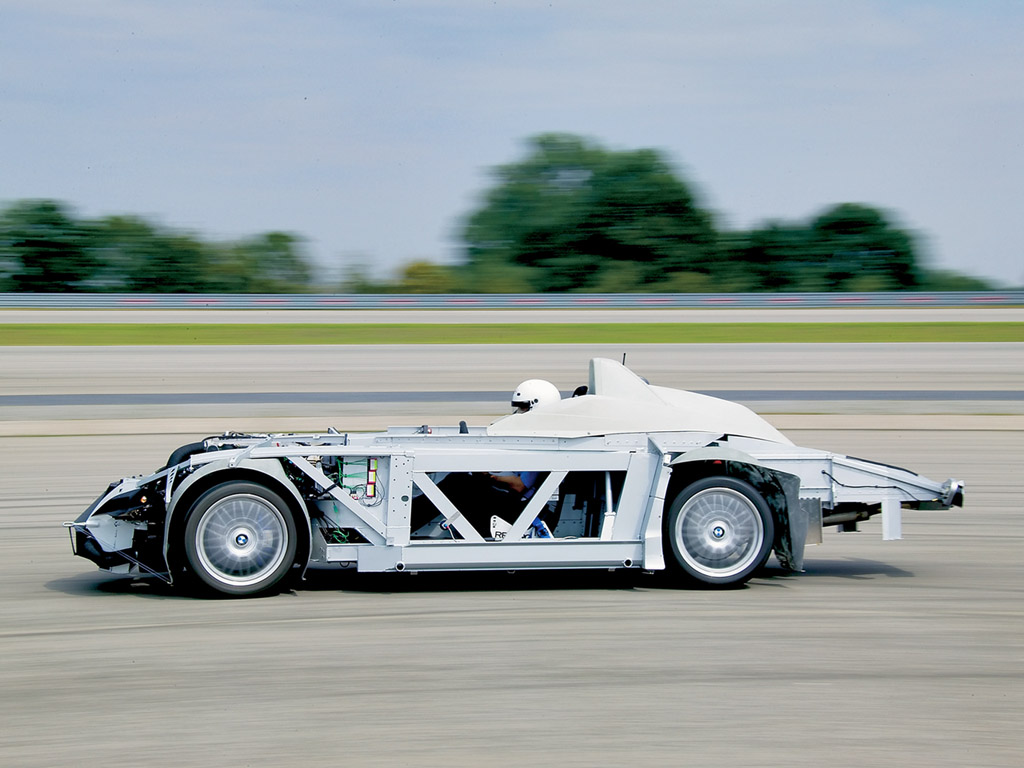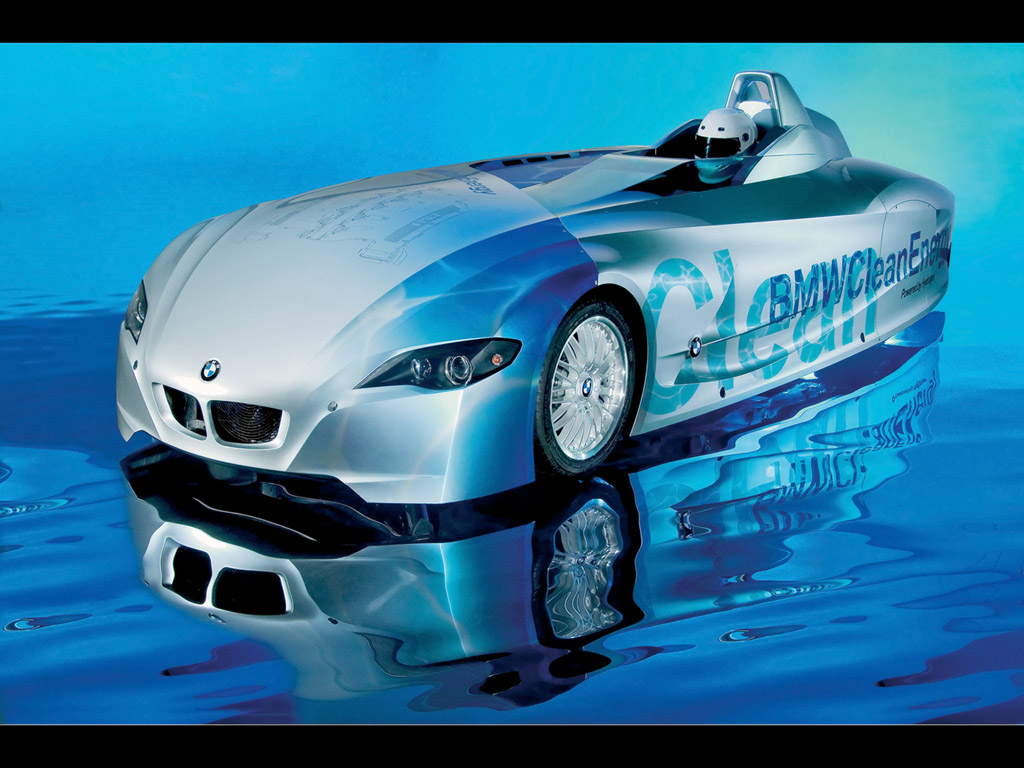2004 BMW HR2
|
Price |
-- |
Production |
-- | ||
|
Engine |
6 liter hydrogen V12 |
Weight |
3440 lbs | ||
|
Aspiration |
-- |
Torque |
-- | ||
|
HP |
285 hp |
HP/Weight |
12 lbs per hp | ||
|
HP/Liter |
47.5 hp per liter |
1/4 mile |
14.9 @ 97 mph | ||
|
0-62 mph |
approximately 6 seconds |
Top Speed |
185.5 mph |
(from BMW Press
Release) Hydrogen does not only mean top performance in
rockets traveling to outer space: BMW has proven what the hydrogen
car is capable of, setting 9 records for cars powered by a
hydrogen-fuelled internal combustion engine. "Nine records marking
the start into the hydrogen age. BMW technology has already come a
long way. Now, together with politicians and the energy industry, we
must turn our vision of sustained mobility into reality", stated
Professor Burkhard Göschel, Board Member of the BMW Group, during
the speed record trials in Miramas. Achieving this amazing success
at the high-speed Miramas Proving Grounds in France, the BMW Group
has clearly proven its conviction that hydrogen is able to replace
conventional fuel without requiring the driver to compromise dynamic
performance.
The specifications of the H2R Record Car are a testament to this
possibility. The 6-liter V12 engine develops an output of more than
210 kW or 285 bhp. This engine propels the BMW prototype to 100 km/h
in approximately 6 seconds and gives it a top speed of more than
302.4 km/h (185.5 mph). Based on the gasoline power unit featured in
the BMW 760i, BMW's hydrogen combustion engine boasts the most
advanced technologies such as BMW's fully variable VALVETRONIC valve
drive.
The main modifications to the engine involve the fuel injection
system adapted by BMW to the special attributes and requirements of
hydrogen. The H2R Record Car benefits from the results gained in
series development of BMW's future hydrogen engine for the world's
first premium sedan built for dual-mode operation.
BMW will launch a dual-mode version of the current 7 Series during
the production cycle of the present model, thus introducing the
first car of its kind able to run on both hydrogen and gasoline.
The H2R prototype set the following records shown here in terms of
times measured and speed achieved:
BMW works drivers Alfred
Hilger, Jörg Weidinger and Günther Weber took turns at the wheel of
the Record Car during their record-breaking session.
BMW's motive in setting up these records was not only to prove the
power and performance of the hydrogen engine. In addition, the
reliability and durability of the technology used clearly
demonstrates BMW?s leadership in developing the hydrogen engine to
production standard. In this process BMW is concentrating on the
combustion engine, simply because the combustion power unit, given
the sum total of all its features and characteristics, still offers
the largest number of advantages and benefits all in one.
The H2R Record Car: developed in just 10 months
The BMW H2R Record Car
was conceived, designed and developed by BMW Forschung und Technik
GmbH, the legendary subsidiary of BMW AG. The expressive, purposeful
exterior design was created by DesignworksUSA, the California-based
strategic design consultancy owned by BMW Group. The name ?H2R?
stands for ?Hydrogen Record Car?.
"We had just 10 months to develop the H2R prototype", states Jürgen
Kübler, the H2R Project Manager. But a short time span like this is
quite normal for the creative engineers that make this Company so
very special.
In the process the engineers and development specialists were of
course supported by three factors: First, the components featured in
BMW's hydrogen production car of the future have now reached a high
degree of maturity allowing their straightforward adaptation for the
record car. Second, the development specialists were able, in the
development process, to use proven BMW chassis and suspension
systems which matched the strict requirements. And third,
far-reaching use of CAD technology allowed for an effective and
efficient development process.
The engine: series production 12 cylinder specially adapted for hydrogen
The "heart" of the H2R
Record Car is based by and large on BMW's top-of-the-line power
unit, the Company's 6.0-liter V12. It is able to run on hydrogen
fuel through the adjustment of engine management as well as the
fuel/air mixture formation components.
The most significant differences in terms of the engine's structural
components are the hydrogen injection valve and the choice of
materials for the combustion chambers: Contrary to the production
engine with fuel injected directly into the combustion chambers
themselves, the injection valves in the hydrogen engine are
integrated into the intake manifolds. And for the specific speed
record requirements to be fulfilled in this case the hydrogen
combustion engine was designed and built for single-mode operation,
running exclusively on hydrogen.
This allowed the engineers to set up and tune the engine
specifically for hydrogen requirements, for example by using special
valve seat rings made of an appropriate material. The reason for
this necessity is that hydrogen does not have the lubricating effect
of a conventional gasoline/air mixture. It is worth noting in this
context that this need to cope with a lower level of lubrication has
come up before. With the introduction of unleaded gasoline,
production engines have been built with even stronger and more
resistant materials.
Hydrogen providing enhanced efficiency
The combustion
properties of hydrogen are quite different from those of gasoline or
diesel: While hydrogen burns faster than conventional fuels under
normal air pressure, the combustion temperature is slightly lower
than in the case of gasoline.
Inside the engine the high combustion speed of the hydrogen/air
mixture generates a higher temperature than in an engine running on
gasoline. Engine management of the BMW H2R Record Car has been
modified accordingly. The hydrogen/air mixture is not ignited until
the piston reaches top dead center, thus ensuring maximum output.
With a gasoline/air mixture burning relatively slowly, by
comparison, the mixture must be ignited at an increasingly early
point as a function of engine speed, the pressure peak thus being
reached just as the piston starts to move down.
A significant advantage of the higher combustion pressure of the
hydrogen/air mixture is that the generation of more power from the
same amount of energy means a higher degree of efficiency.
As desirable as the high standard of ignitability of hydrogen within
the engine may be, it also requires a great deal of attention
outside of the combustion chamber. To avoid misfiring, for example,
BMW's engineers have developed a specific gas cycle and injection
strategy, with BMW's VANOS infinite camshaft adjustment
masterminding the share of residual gas according to specific,
on-demand requirements:
Before the hydrogen/air mixture is able to flow into the cylinders,
the combustion chambers are cooled by air to ensure that the
fuel/air mixture is not able to ignite in an undesired, uncontrolled
process.
VALVETRONIC providing optimum conditions for hydrogen drive
Exclusive to BMW,
VALVETRONIC technology serving as a standard feature to mastermind
the valves on the 12 cylinder gives the Company's engine development
specialists an ideal tool for controlling this demanding gas charge
cycle. VALVETRONIC controls not only the duration of valve movement,
but also the actual valve lift. This effect is provided by an
intermediate lever between the camshaft and the two intake valves on
each cylinder infinitely modified in its position relative to the
camshaft by an additional eccentric shaft operated by an electric
motor. Depending on the position of this eccentric shaft, the lever
transforms the "hump" on the cams into a larger or smaller valve
movement.
VALVETRONIC is based on BMW's infinite camshaft adjustment process.
Already well-known under its trade name VANOS, this system is an
integral part of the VALVETRONIC concept. Incorporating a
hydraulically controlled adjuster unit in the camshaft drive, VANOS
modifies the beginning and end of the valve opening period, fully
variable valve management serving to adjust the gas charge cycle in
the 12 cylinder power unit perfectly to the requirements and
characteristics of hydrogen drive.
Special injection valves for hydrogen power
With hydrogen being
injected into the intake manifold as late as possible, the injection
valves have to meet very demanding requirements. Hence, the valves
are a trendsetting new development for BMW. And since gaseous
hydrogen takes up a larger volume per unit of energy than liquid
gasoline, the hydrogen injection valves are larger than conventional
injection valve units.
In addition, the valves have to cover a far wider range of different
requirements, operating under all kinds of system pressure levels
and with injection periods ranging from very short to relatively
long. One of the main objectives in developing the valves was to
inject exactly the right amount of hydrogen required into the intake
manifold within a very short time-frame at very high engine speeds
and under full load.
A clean mixture formation process:
less fuel consumption under part load, extra power under full load
Under full load the 12
cylinder power unit runs on a fuel/air mixture of
lambda = 1. This is exactly the same mixture we find on a
state-of-the-art gasoline engine and one which, in principle, offers
the highest and most efficient power output in a combustion engine.
Under part load - again a significant benefit offered by hydrogen -
the engine runs efficiently in the lean burn mode with surplus air.
Under specific conditions, that is with a specific fuel/air mixture,
the combustion of hydrogen leads to the generation of nitric oxides.
This mixture "slot" starts slightly above lambda = 1 and extends to
the range of lambda > 2.
The simple solution to this problem is to leave out this mixture
"window" altogether, since it is not required for running the
engine. Hence, the fast management system controlling the BMW
hydrogen engine skips this operating range completely, thus avoiding
NOx emissions in the process. As a result, the H2R Record Car?s
emissions are limited, for all practical purposes, to nothing but
steam.
Safety technology
The fuel system featured
in the BMW H2R Record Car is based on a proven series development
concept. Fuel is filled into the tank of the H2R prototype at a
mobile hydrogen filling station through a manual tank coupling. The
vacuum-insulated, double-walled tank has a capacity of more than 11
kilos of liquid hydrogen and is fitted next to the driver's seat. A
total of three valves ensure optimum safety, the operating valve on
the tank opening at a pressure of 4.5 bar.
Two additional safety valves rule out any dangerous consequences of
possible leaks in the jacket around the tank serving to keep the
hydrogen at the low temperature required, opening up as soon as
pressure within the tank exceeds the limit of 5 bar. This
double-redundant safety system guarantees optimum safety at all
times, ensuring that the hydrogen tank will not burst as a result of
excess pressure.
Heat exchanger instead of a gasoline pump
Gas pressure builds up in the fuel supply system simply because of the rising temperature of the cryogenic, liquid hydrogen in the tank and is kept at an operating pressure of approximately 3 bar by a tank pressure controller. Then the coolant running within the 12 cylinder power unit warms up the hydrogen gas in a heat exchanger to ambient temperature.
Valve technology
Additional valves
monitor the pressure of gas in the fuel pipes leading to the engine:
Cold low-temperature valves inside the tank control the removal of
hydrogen from the tank itself. Should any of the pre-flow pipes
develop a leak, with supply pressure dropping below 0.4 bar, the
fuel supply valves close automatically, disconnecting and sealing
the tank off from its surroundings. The supply pipe can also be
interrupted manually by an interruptor tap.
To maintain optimum supply pressure on the injection valves at all
times ? especially as this pressure may vary as a function of
driving conditions ? engine management reduces pressure in the
supply pipe to approximately 1.2 bar by means of a control valve
fitted specifically for this purpose.
This comprehensive safety system featured in the H2R Record Car is
supervised additionally by a telemetric system of the same type as
in Formula 1. Four hydrogen sensors fitted at neuralgic points - for
example in the tank itself and around the tank coupling - recognize
any leakage immediately and inform the driver accordingly.
Chassis and suspension
Focusing on the
structure and chassis of the BMW H2R Record Car, the engineers and
development specialists at BMW Forschung und Technik GmbH used
series components carried over from a sophisticated, thoroughbred
BMW sports car: the monocoque aluminum spaceframe as well as the
entire chassis and suspension system. High-strength aluminum
structure panels using the advantages of aluminum as a particularly
light material resistant to corrosion fill in the open spaces
between the extra-large extrusion-pressed profiles giving the car
its stable "skeleton".
The result for the driver is a very stable driving experience
without the slightest vibration or body "tremble".
The front suspension is based on a double-wishbone spring strut
front axle together with rack-and-pinion steering, aluminum track
control arms, a tiebar, and an anti-roll bar. The front axle
subframe is formed by a welded aluminum structure made up of
extrusion-pressed profile bars and plates holding all front axle
components and bolted to the body at six points. The track control
arm made of forged aluminum comes complete with two ball joints in
the interest of precise wheel guidance and directional stability.
Wheel guidance and stability at the rear is provided by an integral
four-link axle, a multi-arm principle patented by BMW and rounded
off in this case by an anti-roll bar. Optimum road contact and
safety, finally, is ensured by tires measuring 245/40 x 19.
The bodyshell: outer skin made of carbon fiber
The designers have also
given the H2R Record Car a truly unique body: ?We wanted to embrace
the aerodynamic requirements we defined in the wind tunnel with a
form language that was appropriate to the purpose of the car; the
results are a true expression of the car's functional requirements
and objectives to be clean, fast, and uniquely BMW," said Michael
Scully, Senior Designer of DesignworksUSA , who combines his intense
involvement in motorsports with the intellectual and aesthetic
challenges of multidisciplinary design.
Measuring 5.40 meters in length and 2 meters in width, the body of
the car is designed through and through for optimum streamlining.
And to reach record speeds, the frontal area measures just 1.85
square meters and the drag coefficient is a mere 0.21. At the rear a
20-centimeter-long diffuser prevents air swirl behind the car, which
might potentially slow it down.
The side profile and sheer length of the H2R prototype also serve to
ensure stable driving characteristics at very high speeds. Like on a
Formula 1 racing car, the outer skin is made of carbon-fiber
reinforced plastic offering the optimum combination of superior
stiffness and low weight: Overall weight of the H2R with a full tank
and the driver at the wheel is 1560 kg or 3440 lb.



